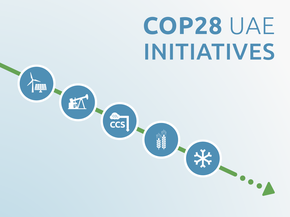Country summary
Overview
In the year of its COP presidency, the UAE is one of the first governments to have submitted a new NDC to the UNFCCC, with a strengthened emissions reduction target. However, there is still too little action in the real economy. The UAE is planning to increase fossil fuel production and consumption, which is inconsistent with limiting warming to 1.5°C, and means it won’t be able to meet its NDC target. Emissions will continue rising through to 2030, when they should be going down by 35% below 2021 levels to be 1.5°C compatible.
Because of its new and stronger NDC target, the CAT’s overall rating for the UAE has improved from “Highly insufficient” to “Insufficient”, but with uncertainties around how the UAE plans to achieve the target, its planned fossil fuel developments would also render it unachievable.
The UAE’s new NDC sets a target of reducing emissions to 185 MtCO2e by 2030 (excluding land use, land use change and forestry), a 14% decrease below its previous target issued in 2022 and 13% below current emission levels. The CAT rates this target as “Almost sufficient” compared to modelled domestic pathways and “Highly insufficient” when compared to the UAE’s fair share – both sub-ratings having improved with the new NDC.
We estimate the UAE will miss its NDC by a large margin, and it therefore needs to put in place additional policies to reduce emissions. The CAT rates the UAE’s policies and action as “Insufficient”. With less than seven years to go until 2030, the gap between the UAE’s current policies, its NDC target and a 1.5°C compatible trajectory remains worryingly large.
In July 2023, the UAE updated its 2050 Energy Strategy. The updated strategy includes a 30% “clean power” capacity target by 2030 and removed the previous 12% share of coal power from its 2050 target. The UAE has also announced an investment of USD 54 bn in renewables over the next seven years to support its 2030 target. However, the strategy still foresees a large role for fossil gas in 2050, which is at odds with the UAE’s stated goal of reaching net zero emissions by then.
Given this continued development of fossil gas, it is unclear how the UAE plans to reach its 2050 net zero emissions target. The UAE’s latest NDC mentions they plan to develop carbon capture and storage as well as direct air capture, but without specifying the scale of emissions reductions and removals this would represent.
The UAE is the world’s seventh largest oil producer and it is planning to significantly increase oil and fossil gas production in the next years, as part of its goal to reach “gas self-sufficiency” and increase exports. In this context, it has heavily invested in ramping up its offshore gas production, after the discovery of fields with up to 57 billion cubic metres (bcm). To support its production targets, the UAE’s national oil company (ADNOC) has set out a USD 150bn investment plan for oil and gas expansion.
Emissions in the UAE appear to have decreased between 2015 and 2020, notably due to efficiency increases in the use of gas in the electricity sector and more recently due to the COVID-19 pandemic. However, there are significant uncertainties in historical emissions. The UAE’s last greenhouse gas emissions inventory is from 2014, and there are large discrepancies in historical emissions reported by other sources, particularly for energy-related CO2 emissions.
Overall, there are some positive developments in the UAE since our last update, including:
- The submission of a stronger NDC target, now presented as an absolute emissions target instead of a reduction below a business-as-usual scenario.
- Some other improvements in its NDC, including information on the sectoral breakdown of emissions and especially the role LULUCF removals are expected to play towards its achievement.
- Continued investment into large scale renewables both at home and abroad.
To improve its climate action, the UAE could:
- Update its energy sector policies and rapidly diversify its economy away from fossil fuels both domestically and for exports, a necessary step to make the UAE’s 2050 net zero ambitions credible.
- Clarify how it plans to reach its 2050 net zero target as part of its upcoming Long-Term Strategy to be submitted before COP28, and what role it foresees for negative emissions technologies and carbon capture and storage.
- Improve the transparency of the information presented in its policies and data. This includes clarifying the baseline for its 2050 energy efficiency target, providing emissions projections under current policies (in addition to targets) and improved historical emissions data.
The CAT rates the United Arab Emirates’ climate targets and policies as “Insufficient”, a rating that indicates the UAE’s climate policies and commitments need substantial improvements to be consistent with the Paris Agreement’s 1.5°C temperature limit.
With the submission of a new, stronger NDC target, the UAE's improved overall rating from “Highly insufficient” to “Insufficient” is a step in the right direction. However, the UAE’s climate policies still need substantial improvement to put it on track to meets its new target.
We rate the UAE’s 2030 climate target as “Almost sufficient” when compared to modelled domestic emissions pathways and “Highly insufficient” when compared with its fair share contribution to climate action.
Overall, the UAE’s climate targets and policies are not stringent enough to limit warming to 1.5°C and need substantial improvements.
Note: We are in the process of updating our temperature ratings associated with the emissions cuts needed within countries' borders to be in line with the latest science (the AR6 scenario database), so our ratings may change in the future once this update is complete.
We rate the United Arab Emirates’ policies and actions as “Insufficient” when compared with modelled domestic emissions pathways. The “Insufficient” rating indicates that the UAE’s policies and action in 2030 need substantial improvements to be consistent with limiting warming to 1.5°C. If all countries were to follow the UAE’s approach, warming would reach over 2°C and up to 3°C.
Current policies are still set to lead to increasing rather than decreasing emissions in 2030, due to a continued expansion of fossil fuel production and use. The UAE is also developing both nuclear and solar power and is well on track to meet its 30% “clean” energy capacity target by 2030 and its 50% target for 2050, but these developments will not reverse the emissions increase.
The full policies and action analysis can be found here.
We rate the UAE’s latest, 2023 NDC target as “Almost sufficient” when compared with modelled domestic emissions pathways – up from “Insufficient” under its previous 2022 NDC. The “Almost sufficient” rating indicates that the UAE’s 2030 NDC target is not yet consistent with limiting warming to 1.5°C but could be, with moderate improvements. If all countries were to follow The UAE’s approach, warming could be held below—but not well below—2°C.
Our methods do not provide a clear answer as to whether the UAE should provide climate finance. On balance, the CAT methodology shows that the provision of a comparatively small amount of international support is consistent with the wide range of literature on fair share contributions to meeting the Paris Agreement's goals.
We rate the UAE’s latest NDC target as “Highly insufficient” when compared with its fair share contribution to climate action – up from “Critically insufficient” under its previous NDC. The “Highly insufficient” rating indicates that the UAE’s 2030 NDC target is not at all consistent with limiting warming to 1.5°C. If all countries were to follow the UAE’s approach, warming could reach over 3°C and up to 4°C.
We evaluate the UAE's net zero target as: Poor.
In October 2021, the UAE announced its intention to reach net zero by 2050, as part of the UAE Net Zero 2050 strategic initiative. During COP27, the UAE presented its “National Net Zero by 2050 pathway”. In March 2023, the UAE’s member states signed the UAE Governments Net Zero 2050 Charter, further signalling their commitment to reaching net zero.
To date, these announcements lack information on scope, target architecture, and transparency. The UAE specifies in its latest NDC that the target covers “the entire UAE economy” which we interpret as covering all sectors and gases. As of March 2023, the UAE has yet to submit a long-term strategy to the UNFCCC, but it is expected to do so ahead of COP28.
Further analysis
Latest publications
Stay informed
Subscribe to our newsletter




